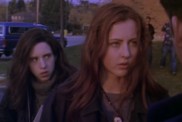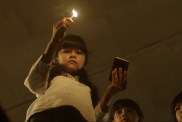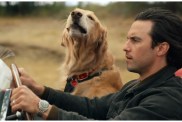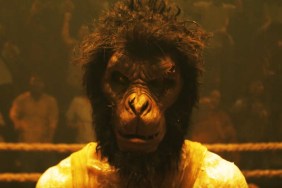Following beloved adaptations of novels like Dear John, A Walk to Remember and The Notebook, Nicholas Sparks’ The Lucky One arrives in theaters this Friday from director Scott Hicks.
Zac Efron stars as Logan, a young Marine who has just completed his third tour of duty. Suffering from post-traumatic stress after a near-fatal encounter in the Iraqi desert, Logan comes to believe that a mysterious photograph he found during his time there is the good luck charm that kept him alive. Returning to Colorado, Logan sets off to find the woman in the picture and, along with his dog, walks across the country to Louisiana and enters the life of Beth (Taylor Schilling), a single mother struggling with the recent loss of her brother.
Hicks, the man behind Shine, Snow Falling on Cedars and Hearts in Atlantis, spoke with ComingSoon.net about the Louisiana-based production, working with both Efron and Schilling and weaving a tale of loss through the use of negative space.
Also, be sure to check out ComingSoon.net report from the set of The Lucky One by clicking here.
ComingSoon.net: Nicholas Sparks’ name carries a certain amount of weight being attached to a story. What are the pros and cons of having that association with a project?
Scott Hicks: The pros are that there’s obviously a big audience out there that is very interested in both his books and the movies that are made from them. The con is, what if you don’t find them? (laughs) I mean, my job as a filmmaker is to take that story and hopefully present it to that audience because they are out there and there is a big demand for this kind of film and this sort of storytelling. You do the best film you can and that’s all you can do.
CS: You were shooting the entire film around New Orleans and it actually contains some Iraq war scenes. Can you talk about finding a way to double Louisiana for Iraq?
Hicks: We had to shoot them last because we had to buzz cut Zac’s hair. Once we did that, there was no way of making it longer. So they were left until literally the last days of shooting we had in December of 2010. It was a challenge because Louisiana is a heart-stoppingly beautiful state. The places where we were shooting were lush and gorgeous and right on the banks of the Mississippi. How are we going to make this like Iraq? It was a challenge, but I had a really first-class design team and designer in Barbara Ling. They were able to create this amazing environment in which we shot those scenes. You’ve got to have good people to rely on.
CS: It’s not Louisana in the book, but the change of scenery allows for some really interesting shots. There’s one in particular where you’ve got a lush, green bridge with a treehouse in the foreground.
Hicks: Oh yes! That’s the gorgeousness of that landscape and that ravine with the creek running through it. Later, of course, it becomes quite ominous and has a hand in the climactic scenes of the film. It was just right there on the property that we were filming on a few miles out of New Orleans. There was this wonderful old house that had suffered some during hurricane Katrina, but had survived that and many other things before. There were so many intriguing elements around it that we didn’t have to move far from the house for a lot of it for the locations that we used.
CS: Did you spend a lot of time in Louisiana beforehand just to get the feel for everything?
Hicks: Somewhat. There’s quite a few weeks spent actually looking for locations. I always enjoy that process because you get to see a lot of the state or the area that you’re in. One of the big challenges is, if you look where New Orleans is and draw a big circle around it, it’s about 80 percent water in that circle with the whole Delta there. Finding locations was quite a task. We had to look quite a bit further to find some of the principle locations. As a state, it’s just remarkably beautiful and quite a gift for a filmmaker because it’s hard to find an ugly shot, quite frankly.
CS: It’s also a film with a slower pace to it, so the necessity of the visual seems amplified.
Hicks: Yes and I think that does add sort of layers to the romance through the layering of imagery that you can create. I’m always a very visual director anyway because I feel that the image contains a large part of the emotional connection that you feel with the film. Sure, it’s the characters that are your mainstay but, as a filmmaker, you can really help that by making something visually enticing and sometimes complex and layered with lots of sort of elements in the frame. That’s part of my job as director.

CS: There’s something very realistic about a lot of the characters in this in that Taylor Schilling’s character was previously married and has a kid. It’s a not a fairytale life.
Hicks: That’s an interesting point of difference with some of the Nicholas Sparks stories that have been filmed before and quite a complication in the story of “The Lucky One.” Yes, Beth has a young child and she’s a couple years older than the character that Zac is playing, Logan. It’s not such an easy jump for her to leap into a relationship with someone. She has an aggrieved ex-husband who’s a bit of a bully and he’s not in the background. He’s right there, front and center. I think those elements add a different sort of layer to the film than we’ve seen in different Nicholas Sparks movies. I like that. I think it added a bit more to the characters and a bit more depth and more reality to the world that they’re inhabiting.
CS: Speaking of the ex-husband as a bully, is there ever a threat of maybe pushing him as a villain too far?
Hicks: I always have this belief that, even if someone is a villain, let alone just an antagonist like Clayton in “The Lucky One,” that they always have to have some sort of humanity to them or else they become some sort of cut out monster or ogre. That feels fake in the end. I’m always a believer that you must sense the other side of people and that nobody is just out and out evil. Or it’s very rare. That was certainly the case in this movie. Jay Ferguson, who is a wonderful actor from “Mad Men,” brings a sort of humanity to Clayton in a rather unexpected way. Quite late in the piece, you begin to feel for him whereas, early on, you’re thinking he’s just this guy who’s making Logan’s life a misery.
CS: You have Taylor Schilling opposite Zac Efron. She’s coming into this as a relative unknown.
Hicks: Interesting, she was the first person I saw for the role and, through the whole process of meeting people and canvasing things and auditioning, she never left my mind. There was something so immediate about her and the way that she accessed her emotions. She actually had the gift of appearing utterly spontaneous. That’s the hallmark of a really great actor. It’s one thing to have technique and the ability to harness that technique, but it’s another thing to hide it. That’s the ultimate necessity, to be able to throw a curtain over it and not let anyone see the gears moving. Taylor is absolutely that kind of actor. It’s a sense of conviction in what she’s doing. She’s remarkable.
CS: In any love story there are certain givens that an audience is going to expect to see. Was there anything you consciously tried to avoid or directly subvert?
Hicks: I try to push it away. Denise Di Nobi, the producer, is tremendously experienced and has done many of these Nicholas Sparks films. She was interested to show me how these scenes work and I said I thought I had an idea. I had that shower constructed outside the shack that Logan lives in where they ultimately come together. It was a bit puzzling to her at first what I was up to. When I shot the material, I think she could see that the way I was going to do it was markedly different. I wanted to try and capture something quite hot within the bounds of the rating that the film had to have, which was PG. The clue to that was really lying in concealing more than you reveal. You give the audience the feeling that you’re revealing quite a lot. It’s really a balancing act.
CS: It’s an interesting build, too, because it happens much later in the film than one might expect.
Hicks: Yes, and, by formula, I remember one day that we were reading through the script and Denis said, “They’re usually kissing by page 40.” (laughs). I went, “Really?” and she said, “They don’t kiss until page 65.” I said, “We’re making a slightly different thing here. We have a different dynamic. They have a child. We have this aggrieved ex-husband. There’s a different set of elements in the mix. That’s going to delay the romance suddenly exploding. But when it explodes, I want it to happen with a bang and release this erotic charge that’s been pent up between these two people.” Zac and Taylor had a great rapport and a great feel for each other on the screen. That was what I was aiming for.
CS: The story begins with Zac walking across the country from Colorado to Louisiana, but we don’t see it at all. Did you always know that that was going to be a story element that only appears through reference?
Hicks: It was about pace. There’s only so many scenes where you can imagine somebody walking with a dog. To me, it was emblematic of his story and I tried to choose certain settings and situations that had almost a sort of fable element to it to suggest this walk. Later I think it’s almost a surprise to learn that he’s walked this distance. I don’t think there’s any harm in that because, when he first meets Beth and she can’t believe he’s walked this distance, of course he sounds like a nutcase. Which, in some ways, he is. He’s obviously been sort of damaged from his war experience. It’s nice to have it be a surprise because we’re sharing her surprise.

CS: There’s a Werner Herzog quote where he says that, “Tourism is a sin and travel by foot, a virtue.”
Hicks: (laughs) Well, I hope he likes this movie.
CS: You used to write all your own projects and you haven’t in awhile. Is that something that you’re interested in returning to?
Hicks: I’m always closely involved with the writing. On this, there was a lot of rewriting and I worked with Will [Fetters] very closely on that. So I’m still involved. As a matter of fact, I’m working on a screenplay myself at the moment. But it has been awhile since I’ve had a film out that was just myself as a writer.
CS: At this point in your career, what really excites you as a filmmaker?
Hicks: It’s hard to explain it. You don’t go out looking for certain things. You respond to some stories more than others. Really, it’s only later that you think, “Maybe it’s because of this or because of that.” For example, all the films I’ve made you could broadly characterize as adult dramas that are character driven and are about human relationships. That’s very broad but, within that, I think you can always go deeper. I’ve obviously got an interest in family. What is family? How is family constructed? In “The Lucky One”, as well as being a romance between Logan and Beth, it’s how you integrate the kid in this. What’s his role? And the grandmother as well and the ex-husband. It’s not altogether different from the work I’ve done, it’s just in a lighter vein. It also had some real challenges. There’s my first war scene and a big love scene. It’s all great fun.
CS: There’s a big element of negative space in terms of family. We see Logan’s family in the very beginning and the distance that he feels from him. All throughout, there’s a lot of missing character, like Beth’s brother.
Hicks: I’m so glad you said that because that was part of the feeling i wanted in that house, that there was a generation missing. Her parents had died when she was young and she’s lost her brother in the war. There’s a feeling of grief hanging in that house. Logan comes into it, almost like “Shane” or an archetypal character who comes into it and tries to set things right. I’m glad you noticed it because it was a real intention to set that feeling. Once they’re lovers, there’s a scene where he helps her to open up the closed-off rooms of her house. They’ve been shrouded in dust sheets because they don’t need all that space. What he’s literally doing is bringing light into her life. It’s a rejoicing sort of scene but, under the surface, it’s exactly what you’re talking about. There’s something missing in that house.
The Lucky One hits theaters on April 20th.









